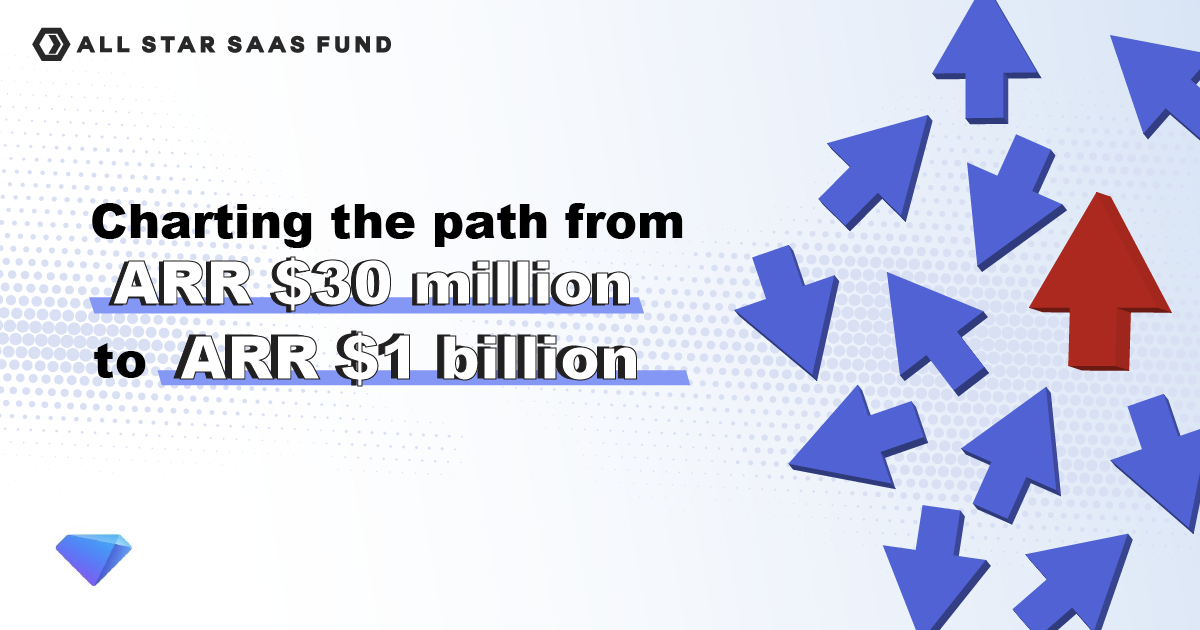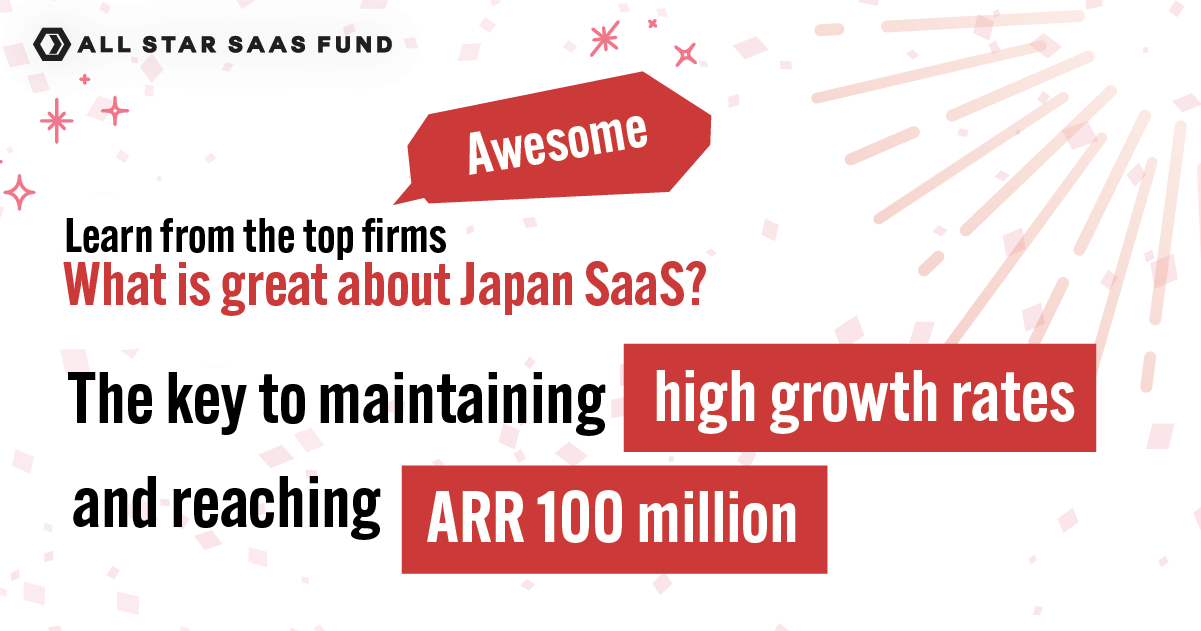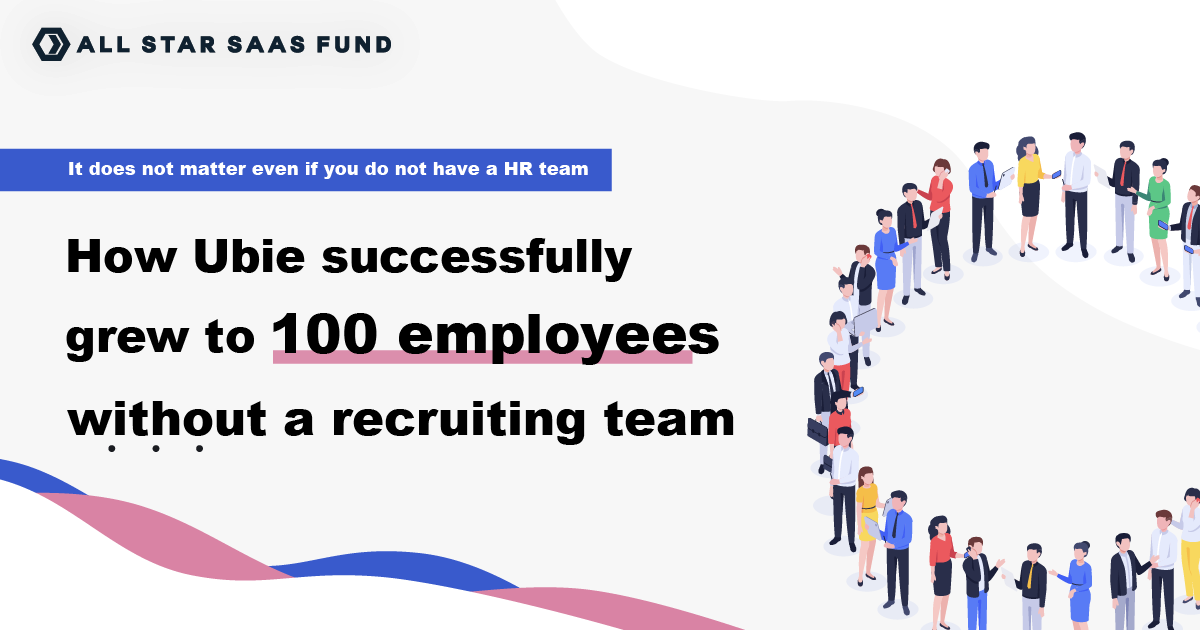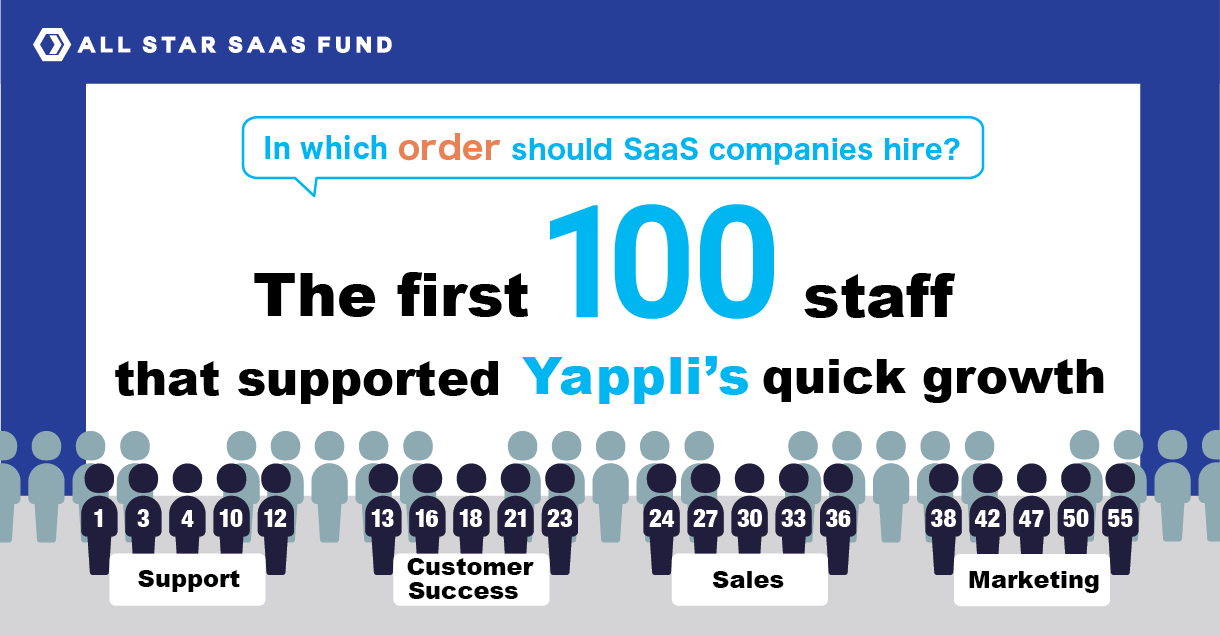Treasure Data is a fast-growing SaaS company which provides a Customer Data Platform (CDP) that enables data collection, analysis and integration that is also gaining traction globally. Previously acquired by UK-based chip designer Arm in 2018, the founding team returned last year to helm the company and take it to greater heights - to the surprise of many in the industry.
While it is well recognized these days for its CDP, Treasure Data actually had to pivot when it already had $30 million AAR (Annual Recurring Revenue) to become what it is today.
CEO and co-founder Kazuki Ohta shares with Hiro Maeda, managing partner of ALL STAR SAAS FUND, the story of how Treasure Data broke through to $100 million and the reasons for the founding team’s comeback.
Reaching ARR $10 million in 3 years, but looming threats from tech giants…
── Glad to have you with us! Firstly, could you tell us about your decision to pivot despite having an ARR of $30 million.
Ohta: We pivoted during our 5th to 6th year of business. At that time, even though we reached $30m AAR, we, the founders, could already foresee a downward trend. The pivot did allow us to greatly re-accelerate our international business growth though.
Treasure Data was born from my research on High Performance Computing (HPC) in university. Back then, you could only do data analysis on-site and it required setting up a huge amount of hardware, networks and software, as well as human resources. Moreover, it took an average of 18 months to run the analysis, with about 40% of the projects failing.
Treasure Data began from my idea that if you tapped on cloud infrastructure for data analysis, there would neither be initial costs nor any further need to employ people. Three years after the start of Treasure Data, the founders were mainly focused on driving sales, and we succeeded in steadily growing until we achieved an ARR of $10 million by securing large clients.
It was at this time though that cloud computing providers like Amazon, Google, and Microsoft started to provide their own infrastructure solutions such as Amazon’s Redshift and Google’s BigQuery. All of them were competing with us, and because of this, customers began demanding lower pricing and higher processing speeds. We were outmatched in terms of funding, R&D capacity and engineer headcount and were therefore forced to pivot.
That’s when we thought to build applications on top of our big data platform and sell products closer to business needs. In other words, we pivoted from selling to other companies’ IT departments to selling to their marketing departments. This pivot dramatically led us to achieving 70% - 80% annual growth.
── Thanks for the reply! By industry standards, attaining ARR $10 million in 3 years would generally be taken as a sign of steady growth. What were the signs that you saw that convinced you to pivot despite this “smooth sailing”?
Ohta: Oh to be frank, even if we could grow our ARR from $10 million to $20 million, we didn’t feel that we had Product Market Fit (PMF). It was sort of feeling like “we were selling the product” rather than “the product’s selling itself”. That could be partly because we were aiming for partnerships with Annual Contract Values (ACV) of more than $100 thousand. This in turn meant that we really didn’t have a scalable sales / marketing funnel.
This was when the previously mentioned tech giants were starting to enter the space and the writing on the wall became increasingly clear. Firstly, our sales representatives struggled. Even with several superstar salespeople, our overall account numbers stagnated and ACV started to drop. Also, one could sign up for AWS or Google’s services from only 1 cent per month and use it immediately whereas we were charging a minimum initial fee of $3,000 per month.
Given this, we could have continued to push for sales, but customers would then ask us “why does it cost $3,000?” and compare our product’s speed against our competitors. The time needed for us to close a sales cycle started increasing too, which in turn naturally led to increased customer churn. At this rate, we felt that it would not be possible to hit all our KPIs.
The 30 minutes that decided Treasure Data’s fate
── Between that time until the decision to pivot, did you receive any words or advice that influenced you?

Birthday celebration with Jerry Yang and Yoshikawa
Ohta: From various sources yes, but our investors were the people who we took most to heart. After all, for entrepreneurs, the most valuable thing you can have is investors who advise you on how to overcome tough times. I still remember meeting Dan Scheinman, who serves on the Boards of Zoom and Sentinel One, and Jerry Yang, founder of Yahoo. In my opinion, the meeting with Jerry was the 30 minutes which completely changed the direction that Treasure Data took. He told me Treasure Data only had two paths left.
One was to follow the strategy of Snowflake – a company similar to ours. Snowflake secured a CEO who worked at a high position at Microsoft and who later raised over $1 billion from Silicon Valley venture capital. In addition, their operations and marketing were top class and they invested heavily to overtake Amazon Redshift. However, we probably wouldn’t be able to replicate such a strategy.
The second was to increase our product’s value-add by providing end-to-end services that would function like apps. That was the path which we chose. In order to know what kind of applications can be developed on top of Treasure Data‘s data analysis platform, we surveyed around 100 clients to hear out all of their needs.
We discovered that most of our clients could get a general sense of customer trends by analyzing customer or user data. However, 90% of the requests for such analyses were made by marketing teams to IT departments who would then be the ones who crunch the data. We started to think “wouldn’t it be good to have an application that would empower marketing teams to handle customer data analysis on their own?”
We started to implement functions which would allow users to create customer lists drawing on multiple data sources, through segmentation or through using search criteria etc. We also added integrations with email, SMS and other marketing tools. These were customer-based customizations which we then expanded into full functions.
Actually, around 2017, there were also competing CDPs with similar capabilities, but we could see that we had a good chance at succeeding.
── At that time, how many competitors did you have in the CDP sector?
Ohta: About 20 to 30 companies I think. The largest of these was Segment, which was recently acquired by Twilio for 3.2 billion. Then again, our previous competitors were Amazon, Google and Microsoft, so compared to these behemoths dealing with 30 smaller competitors instead felt like a load off our shoulders. (Laughs)
Nowadays, we’re increasingly hearing about Product Led Growth (PLG). There are many services that generally rely on developers as the first clients before gradually expanding. On the other hand, CDPs generally require company-wide implementation. After all, companies can extract the most value from them when they integrate data across multiple brands and departments, as opposed to just applying data from individual teams.
In other words, the larger the company, the larger the pain when it comes to dealing with data. We observed that our competitors did not however create products that addressed these pain points. I was thinking, given our expertise in developing a big data platform, we were the only player who could crunch a huge set of complex data to provide insights for marketing strategies.
Right now, there are more than 150 companies providing CDPs, but Treasure Data is the Number 1 in terms of revenue.
Too late for persuasion… marching towards the pivot
── Did anything feel different after pivoting?
Ohta: Well…. It was quite chaotic then (chuckles). Even though I announced the move to creating a CDP, no one was with me. Co-founder Hiro Yoshikawa must also have felt that “he’s saying something crazy.” But he trusted me and I really am thankful to him for standing by my decision. I mean, I even had a VP trying to get rid of me during a board meeting….
── Sounds like some very tough times indeed (laughs). It must also have been difficult to persuade your employees?

Customer Advisory Board Meeting at Napa Valley
Ohta: We had a payroll of 150, and we’d miss the window of opportunity to pivot if I had to persuade all of them. Instead, we followed the strategies stated in “Zone to Win: Organizing to Compete in an Age of Disruption” and “The Innovator’s Dilemma”, which was to form small teams and build prototypes.
I assumed the role of Product Manager and worked with our engineers, UI/UX engineers and designers to create products that we trialed with three of our client companies. Through this, we slowly grew our Monthly Recurring Revenue (MRR) which in turn boosted what our sales team could do. Even so, it did take the company about two years to pivot towards a CDP product and we still have clients who were with us from before the pivot. Even today, about 20% of our revenue is still from pre-pivot products.
Besides making prototypes, we also developed an open-source data collector called “Fluentd”, which we started selling to enterprises. In other words, we pivoted each product and achieved an ARR of $1 million within two years. However, as the CDP had a much higher growth rate, we decided to close Fluentd.
── Are there any signals that one should look out for in the ideation process?
Ohta: I guess one is whether you can see a path to success. To me, market size is critical. If the market is huge, you can still be a big company even if you do not have a good strategy.
Back then, GDPR and CCPA meant that CDPs shifted from just simply pooling customer activity data to properly applying customer data gained with consent. We predicted that this shift from just the “gathering” of data to focusing on its “proper management” would occur in the next 5 to 10 years. Therefore, we decided to bet on this market.
We see this particularly in the explosion in MarTech (Marketing Technology) with 8,000 companies in the space now compared to 5,000 a few years ago. The more the ecosystem grows, the higher the value of CDPs. After all, the more vendors you have, the more silos of data are created.
I’ve heard that an average company now uses approximately 90 SaaS tools, of which a big portion are marketing related tools. This trend will likely continue and with it, the continued growth in the demand for CDPs.
These are market trends that I paid attention to. What could we do to strategize and build competitive advantages for our existing products? And the easier the strategy, the quicker we’d grow. I still had much to learn, but that was my thought process then.
Gaining the confidence to say that only we could solve certain complicated problems
── As the number of your competitors suggests, competition in Silicon Valley is stiff. What do you think are key factors, skills or advantages that need to be developed to succeed?

Brainstorming on product positioning
Ohta: Positioning is key. Looking at the entire CDP market, where you should stake your territory for greatest chances of success… you have to do marketing and sales with this positioning in mind.
In the case of Treasure Data, out of the entire market, about 30% of clients purchase all their software tools from companies such as Salesforce, Adobe and Oracle. We call this behaviour the “Suite Approach”, and most companies that utilize the Suite are well funded.
The remaining 70% of clients will mix and match by choosing Salesforce for CRM, Adobe for web analysis, and Oracle for email etc. In other words, these clients employ a “best of breed” approach, with the drawback that their data will be dispersed.
We decided to adopt a “Vendor Neutral” stance. I.e., “No matter which marketing cloud is being used, Treasure Data will be able to integrate all your data''. This gave us a clear differential point, even versus the giant software vendors.
While about 150 companies occupy the CDP space, Treasure Data positioned itself as a company which specializes in providing enterprise-plan size services for companies with large pain points. We therefore decided to not take on deals that are below ARR $100,000 and focused our marketing and efforts towards this segment.
I emphasize the importance of positioning because there are huge differences between how competitive it is between Japan and the US.
In the US, probably 50 companies will take part in a bid. They’d firstly have to provide information about product functionality and whether they can meet customer requirements. The list gets whittled down to 2 or 3 companies, sometimes companies even need to produce a Proof of Concept as part of the selection criteria. Competition is stiff and the sales cycle is long, it is important that you consider how to shorten this whole process and increasing your average price.
When we look at the history of software, I sense that companies that provide products which can be used globally become the market leaders. For instance, if we look at software to settle business expenses, for a global company with operations worldwide such as Toyota, it needs to have a centralized settlement system that also complies with the rules of each country it operates in. Currently, only Concur can provide this. Price then becomes a non-issue - there’s only one choice available after all. (Laughs)
We are aware that Treasure Data needs to become such a company. Right now, we have clients who have installed our products in offices over 50 countries, but some of these offices are in locations which prohibit transferring data out of the country. We have therefore have data centers in Europe, USA, Japan, South Korea, and we are still expanding. But even with our limitations, we are the only company that provides multinationals with a CDP that works cross-border.
This positioning means that our sales cycle shrinks considerably despite our average selling price also rising significantly. To our multinational clients, we pay close attention to ensuring that we can claim with confidence that we are the only company that can tackle their complicated issues.
You cannot successfully run a business without recruiting and keeping global talent
── In aiming to become a global enterprise company, besides Concur, are there other companies that you take reference from?
Ohta: We don’t actually have that many other companies that serve as case studies but, but like ServiceNow, we focus on the idea of “G2K Penetration”. This refers to the percentage of the top 2,000 global companies by market cap which you have as clients, as well as your average account size with them. We use this as part of our earnings score too.
Investors can then use this to calculate the number of companies which are still green pastures for us for us to gain very high value contracts.
In fact, we actually put in much more resources into pre-sales for this “G2K” segment. We’d for example completely map out the sites and services that they use to create a very comprehensive product demo before showing this to potential clients.
── This strategy to keep close to the client - is it the pre-sales team who is responsible?
Ohta: The thing is that there’s a lot of overlapping fields and departments involved. For example, when it comes to the State of Texas, we have to balance the needs of multiple industries – ranging from finance to CPGs, automotive, retail and so on. We need experts for all of them.
In cases like these, we’d assign someone with say, 15 years in the automobile industry for sales but also attach sales engineers and solutions engineers to ensure that we can handle technical sales too.
In addition, global companies tend to keep important data worldwide, so 40% of their solution requirements revolve around security and regulation compliance. We therefore attach security architects to ensure that the architecture provides not only the safe storage of data but also secure communication between the cloud and the client.
── Well, that’s great! You’d probably be competing with the GAFAM companies to acquire talent, so what’s your secret to Treasure Data’s recruitment strategy?
Ohta: This may not be very valuable, but it’s true to some extent that “money solves everything”. This is how I and Hiro think: those who bear the initial risks need to be rewarded more handsomely. That’s why when we were first acquired by ARM, more than fifty of our employees became instant millionaires. In short, we managed to gain and retain them by providing them with adequate incentives – nothing complicated about that.
Since the pandemic, recruitment competition in Silicon Valley has become much stiffer. In the past three years, especially for engineers who can work remotely, we have been working hard to gather talent from all over the world, including America, Japan, UK, Vietnam, or, in the case of professional services, from India. Time zone and culture differences present challenges but since we’re developing globally, so no matter where you are hired, there will be customers in that time zone.
I personally believe that even on the global stage, there are advantages to being Japanese which you must exploit to win. I’m now in Silicon Valley, but I feel that the level of Japanese engineering is exceptionally high. We need to overcome the language barrier but even now, about 40% of our engineers reside in Japan.
The message from Masayoshi Son which led to your return
── Finally, given that Treasure Data was once acquired by Arm, I was extremely surprised by your return as CEO following your departure. You could have chosen to set up a new start-up or simply lead a comfortable life. Why did you choose to return as Treasure Data’s CEO and lead the company?

Dinner with team members from Arm
Ohta: In the 2 years after the acquisition - or the post-merger integration phase - we constantly working on how Treasure Data should integrate into Arm. You probably hear this a lot but I completely burnt-out because of this. Therefore, last September, I stepped down from the frontline and only attended on the Board meetings. I was still involved in discussions around the company direction but besides that, I was just playing Fortnite.
In actual fact, NVIDIA, the famous GPU manufacturer, was in talks to acquire Arm but it would not buy over Arm’s software department which Treasure Data was parked under. That was the reason why Treasure Data became an independent company under SoftBank Group, which was also approximately when we stepped down.
A new CEO was appointed but in April this year, Yoshikawa and I received a phone call from Mr. Masayoshi Son, asking if we wanted to come back.
Mr. Son probably saw the significance of Snowflake’s – which I mentioned before - 80 billion-yen IPO which was also the largest in history. I’m guessing that he thought, "we have to ensure that our data business is healthy”. And I think they wanted to bring us back partly because companies operated by their founders tend to have higher market capitalization.
However, Yoshikawa was trying to return to a career in venture capital. I was just 36 years old and thinking of starting a new career. My own experience taught me that, building a company, especially in SaaS, would be a long-term battle which required me to pour my life into it for the next 10 or 15 years. At that time, I didn’t find anything which really triggered such a passion in me.
I met Mr. Son, and while the conditions he proposed were indeed attractive, I still didn’t feel any burning passion towards the prospect.
── Why did you decide to return then?
Ohta: No matter what, Mr. Son is a very good people motivator.
Currently, we consider companies with a market value of $1 billion to be unicorns. There are about 500 companies right now which fit this but it’s probably going to reach 700 this year. With so many, unicorns valued at $1 billion would just become mere “ponies”.
Going forward, the criterion to become a “superstar entrepreneur” will be whether someone can create a $10 billion company. Mr. Son was saying that that was the standard that you must reach to be recognized that “you have made it as a man!”
Hearing this from a person who managed to bring SoftBank to such great heights made me feel like I could do more. And if so, why not take up the challenge again at Treasure Data?
I was originally the CTO and so I was involved in the product, engineering, customer success and support parts of the company. But I think that tech only has meaning when it addresses business, marketing, and strategic concerns. I wanted to play a part in this process of “putting the blocks together” and so I decided to return as CEO with the support of Yoshikawa.
Nonetheless, it would be impossible for me alone to run the company. The COO and CFO who was part of Treasure Data prior to the acquisition were free at the time and so we three have returned to lead the company.
── Mr. Son is great at lighting fires in people isn’t he!
Ohta: Definitely! Especially by setting the bar at building a $10 billion company. What I want to stress today is for everyone to not settle for $1 billion – aim for $10 billion instead. It’s important to set your sights high and even if you end up only reaching $1 billion in the end, that too is an achievement.
 ALL STAR SAAS FUND GLOBAL
ALL STAR SAAS FUND GLOBAL







